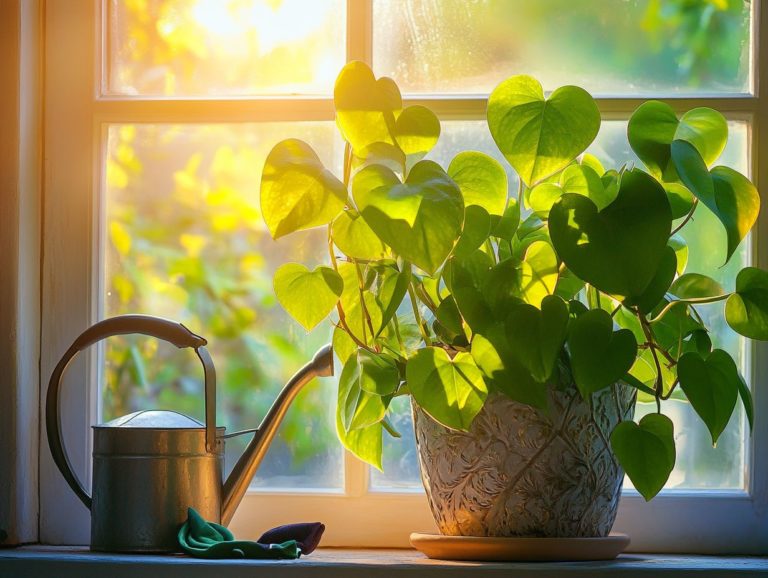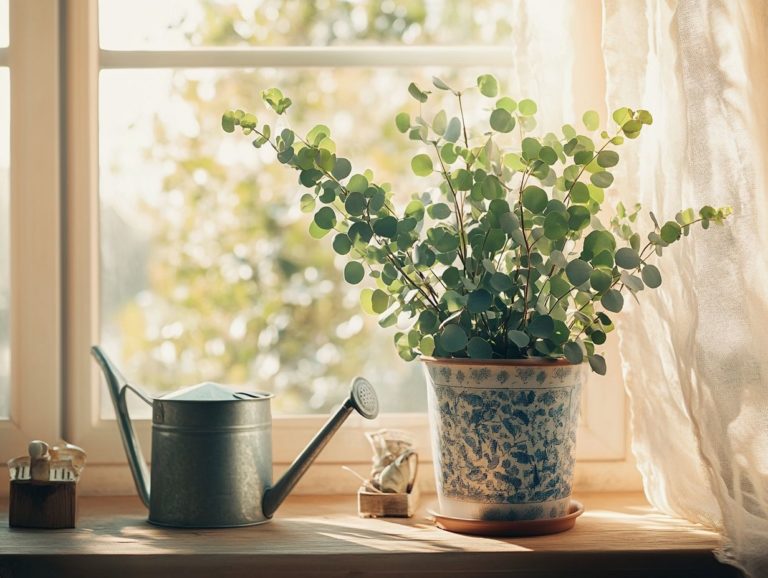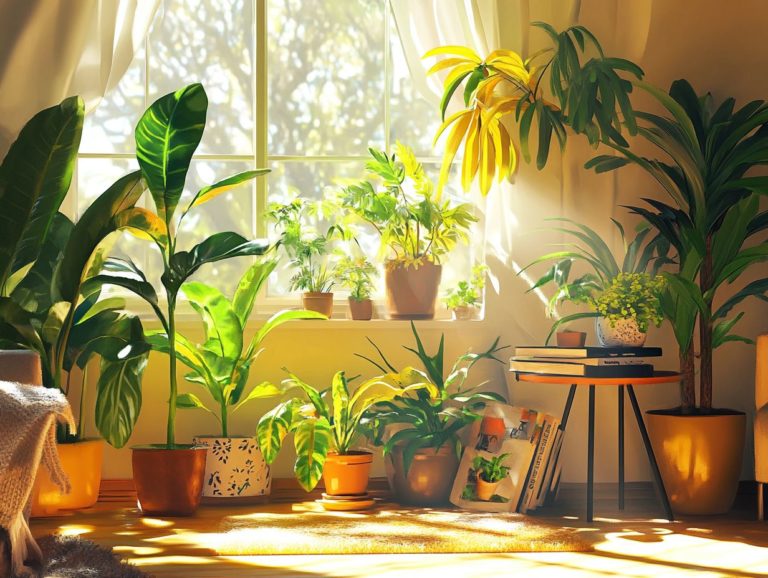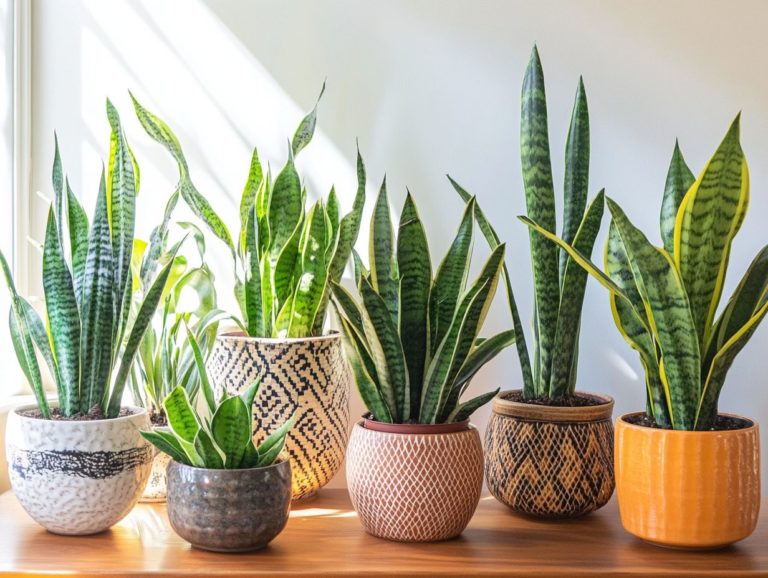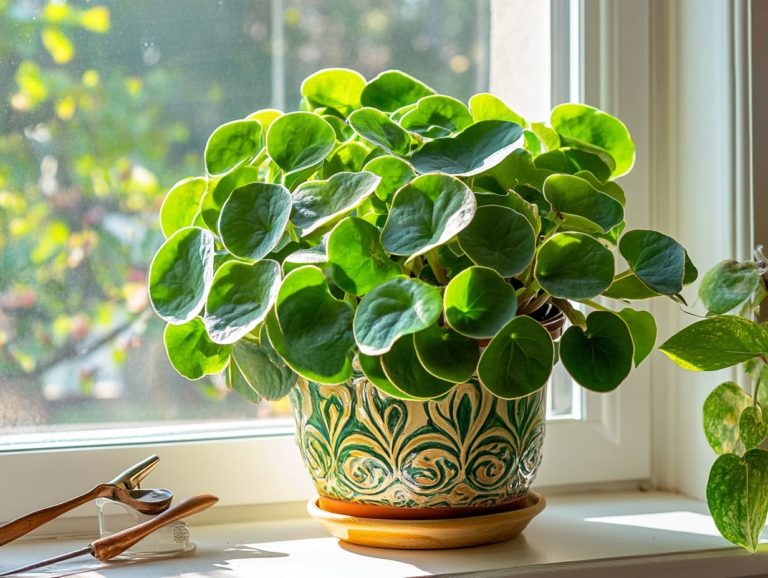How to Care for a Monstera Plant Indoors
If you re a plant enthusiast or just beginning your journey into indoor gardening, the Monstera plant is a stunning choice that can truly elevate your space.
Renowned for its lush leaves with natural holes, this tropical beauty demands specific care to thrive indoors.
You ll uncover essential tips for creating the ideal environment, effective watering Monstera and feeding techniques, and methods for keeping your Monstera healthy through Monstera propagation.
You will also explore common pests and troubleshooting strategies to ensure your plant flourishes.
Dive in now to discover the secrets of thriving Monstera care and transform your indoor garden into a vibrant oasis!
Contents
Key Takeaways:
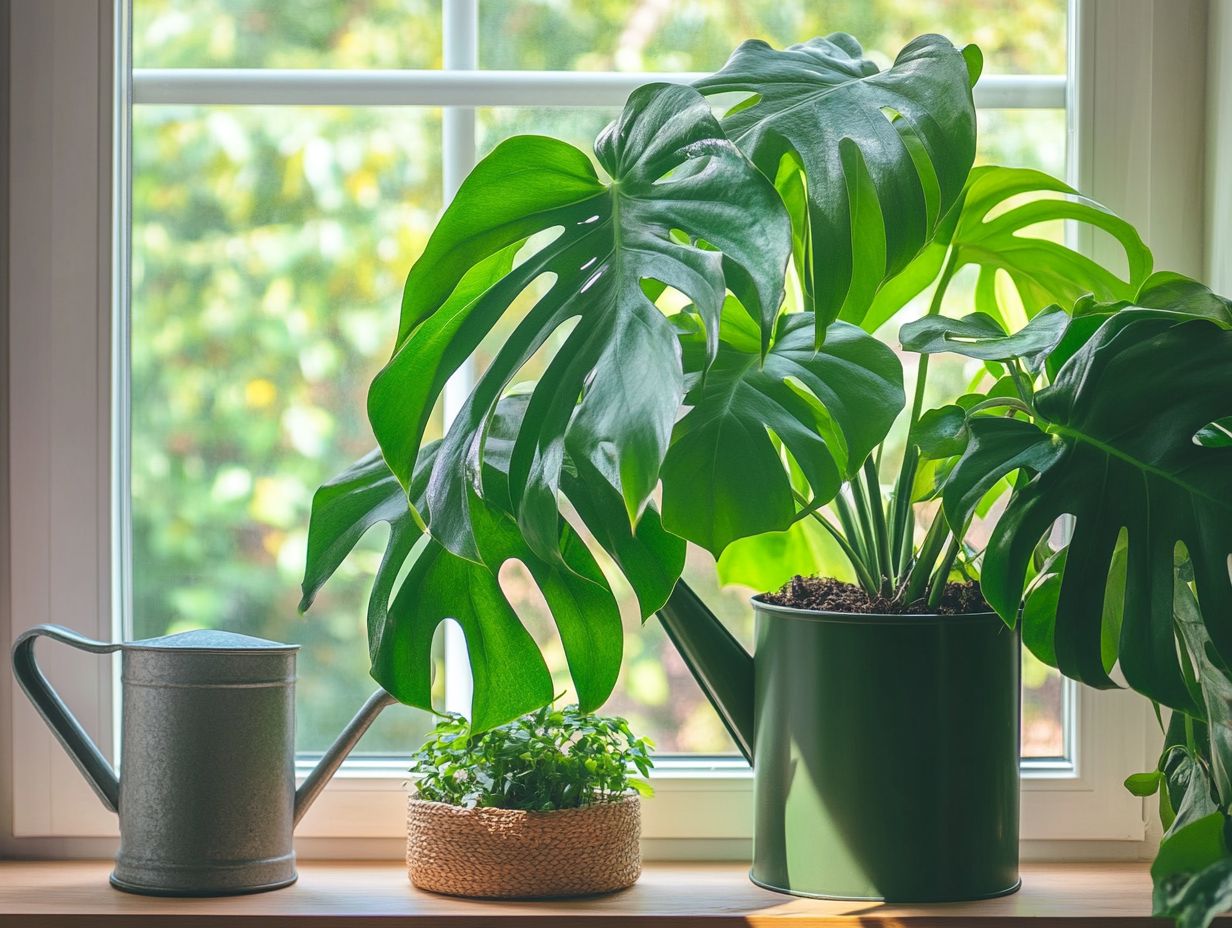
- Choose an indoor environment with bright, indirect light and consistent temperature and humidity for your Monstera plant to thrive. Pay attention to your Monstera humidity needs for optimal growth.
- Proper watering techniques, including allowing the soil to dry out between waterings and using filtered water, are crucial for the health of your Monstera plant. Establish a Monstera watering schedule to maintain its vitality.
- Prune your Monstera plant regularly to encourage growth and use propagation methods to create new plants. Be vigilant against common pests on Monstera and diseases, and troubleshoot any issues promptly to keep your Monstera plant healthy and thriving.
Overview and Unique Features
Monstera plants, especially the Monstera Deliciosa, are becoming must-have indoor companions for your space, thanks to their striking aesthetics and low-maintenance care.
Commonly referred to as the Swiss Cheese Plant because of its distinctive leaf holes, this tropical gem hails from Central America and southern Mexico.
With the right indoor plant care think proper watering, humidity, and light exposure you can help your Monstera flourish, infusing a touch of green elegance into any room.
To keep your Monstera healthy and vibrant, it’s crucial to understand its unique features, such as aerial roots and specific growth conditions.
Choosing the Right Indoor Environment
Creating the ideal indoor environment for your Monstera plants is essential for their growth and overall health. Consider the factors that play a significant role in the prosperity of your Monstera Deliciosa and other species, such as the split-leaf philodendron.
These plants thrive in bright, indirect sunlight and prefer a warm, humid atmosphere that echoes their tropical origins. By understanding these specific needs, you can optimize your indoor plant care routine, setting the stage for your Monstera to truly flourish.
Light, Temperature, and Humidity Requirements
Monstera plants, particularly the Monstera Deliciosa, come with their own set of requirements for sunlight, temperature, and humidity to truly thrive indoors.
These tropical plants love bright, indirect sunlight, similar to the light under their native canopy in Central America and southern Mexico.
Alongside adequate light, you must also focus on maintaining the right humidity levels, as these plants flourish in a humid environment that keeps them healthy and vibrant.
To achieve these optimal conditions, consider placing your Monstera near a south or east-facing window where it can bask in filtered light. Aim for ideal temperatures in the range of 65 F to 85 F, and keep humidity levels between 40% and 60%.
Stay alert for signs of distress; yellowing leaves might suggest that your plant isn t getting enough light or moisture, while drooping leaves could indicate it s time to reassess your watering routine.
To address these concerns, you might invest in a humidifier or simply relocate your Monstera to a brighter spot, ensuring it receives the meticulous care it deserves for exceptional growth.
Start your journey with Monstera care today and see your indoor space come alive!
Watering and Feeding Your Monstera Plant
Proper watering and feeding are essential for ensuring the health and vitality of your Monstera plants. By establishing a consistent watering schedule, you can provide your plants with the moisture they need while avoiding the pitfalls of overwatering. Overwatering can lead to root rot and a host of other problems.
Knowing when and how to fertilize your Monstera can dramatically boost their growth rate and enhance their overall appearance. With the right approach to watering and feeding, your Monstera can truly transform into a stunning centerpiece in your home.
Proper Watering Techniques
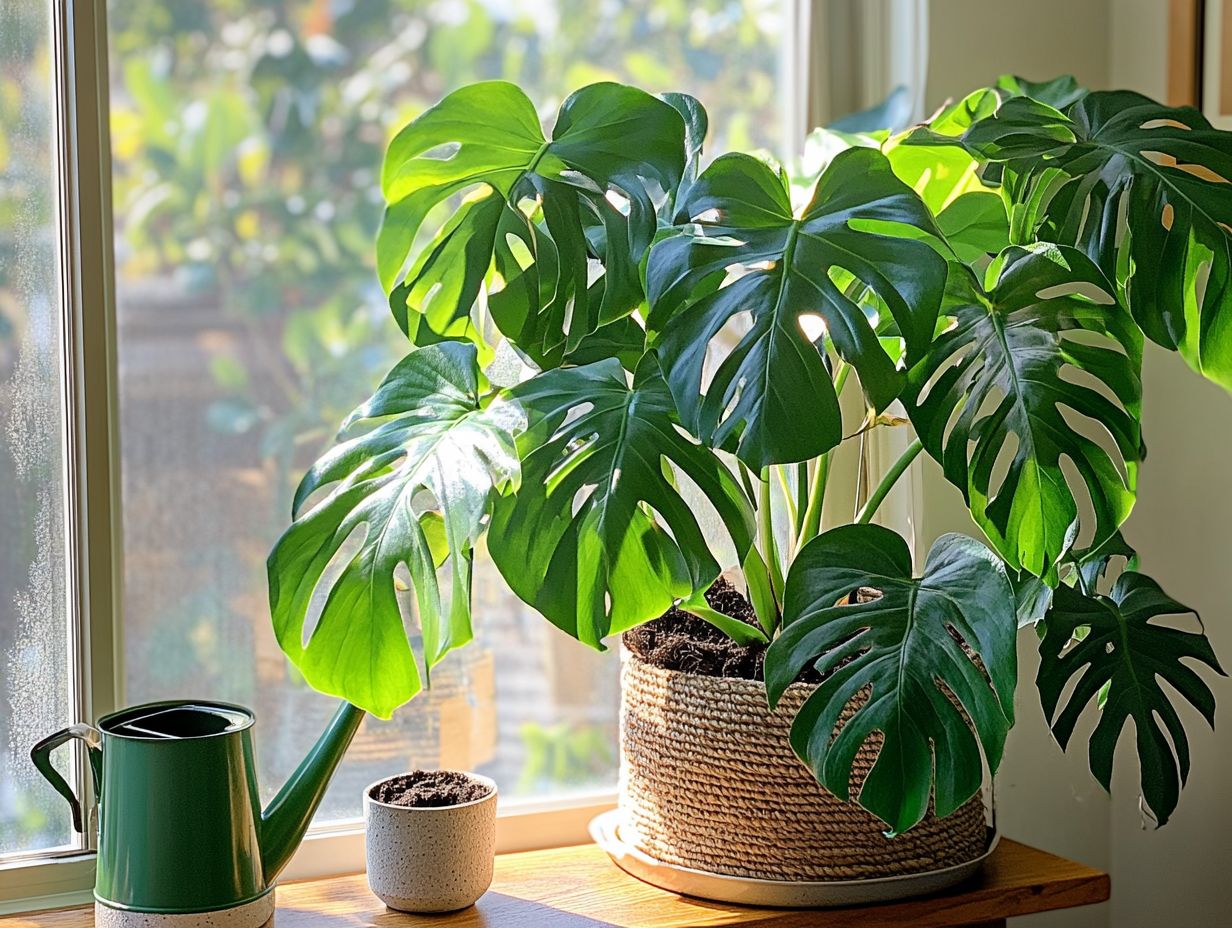
Proper watering techniques are vital for the health of your Monstera plants. Establish a watering schedule that considers the season and your specific environment to avoid overwatering, which can jeopardize your Monstera’s well-being.
Aim to water your Monstera when the top inch of the soil feels dry to the touch. Stick your finger into the top inch of soil; if it feels dry, it s time to water! Ensure that excess water drains effectively to keep those roots happy.
If your plant is in a humid area, it may need less frequent watering compared to those positioned in drier spots. During the vibrant growth seasons of spring and summer, increase the watering frequency to promote robust growth. Conversely, in the fall and winter, you may find that less frequent watering is necessary as your Monstera enters its dormant phase.
Remember, adequate drainage is paramount. Preventing water from pooling in the pot is crucial since standing water can lead to root rot and health issues. By staying attuned to your Monstera’s needs, you can cultivate a lush, vibrant plant that flourishes beautifully in your indoor space.
Choosing the Right Fertilizer
Choosing the right fertilizer is essential for keeping your Monstera plants healthy and thriving. Opt for a balanced, water-soluble fertilizer during the growing season to deliver essential nutrients for robust growth.
Establishing a feeding schedule helps you determine when and how often to fertilize, ensuring your plants receive adequate nutrition without the risk of giving too much fertilizer.
Fertilizers rich in nitrogen support lush foliage development. Those high in potassium can boost overall vigor and disease resistance. Consider applying a slow-release formula during repotting to maintain nutrient levels over time. This feeding rhythm is most effective during the spring and summer months when your plant is actively growing.
Watch your Monstera s growth and leaf color; they provide valuable insight into its specific nutrient needs. This allows you to make timely adjustments to your fertilization routine.
Pruning and Propagation
Pruning and propagation are vital elements of caring for your Monstera. They significantly enhance both its health and visual allure. Regular pruning shapes your Monstera into a stunning silhouette and encourages fresh, vibrant growth while eliminating any damaged or unhealthy leaves.
Propagating your Monstera can be rewarding. You can cultivate new plants from cuttings. Mastering the art of pruning and propagation will elevate your Monstera’s beauty and extend its life, enriching your indoor space for years to come.
How to Prune Your Monstera Plant
Learning how to prune your Monstera plant is essential for maintaining its health and ensuring it remains a striking feature in your indoor space. Regular pruning helps to prevent common leaf issues and encourages bushier growth by removing older, yellowing leaves.
To get started, select the right time to prune; late spring or early summer is perfect when your Monstera is actively growing. Armed with sharp, sterile pruning shears, identify any leaves showing signs of damage or disease, like browning tips or excessive yellowing. Cutting just above a node (the part of the stem where leaves grow) will promote new growth and enhance the plant’s overall vitality.
Consider removing any leggy stems to encourage denser foliage. Keeping your tools clean is crucial it not only prevents infection but also contributes to a thriving Monstera, showcasing your dedication to its care.
Propagation Methods
Propagation methods for Monstera plants enable you to expand your collection and share these stunning specimens with friends. One popular approach involves taking cuttings from healthy Monstera stems, ensuring you include at least one node for successful rooting.
Understanding best practices for Monstera propagation, particularly during transplanting, is crucial for ensuring your new plants thrive. By mastering various propagation techniques, such as stem cuttings, you can enjoy the exceptional beauty of these tropical plants in fresh new settings.
Another highly effective method is water propagation, where you place cuttings in water to encourage root development before transferring them to soil. When it comes time to transplant these young Monstera plants, you’ll want to carefully acclimate them to their new environment, gradually adjusting them to lower humidity levels while keeping a close eye on their moisture needs.
Implementing proper techniques fosters healthy growth and enhances the overall resilience of the Monstera, allowing it to flourish beautifully in your home or garden.
Common Pests and Diseases
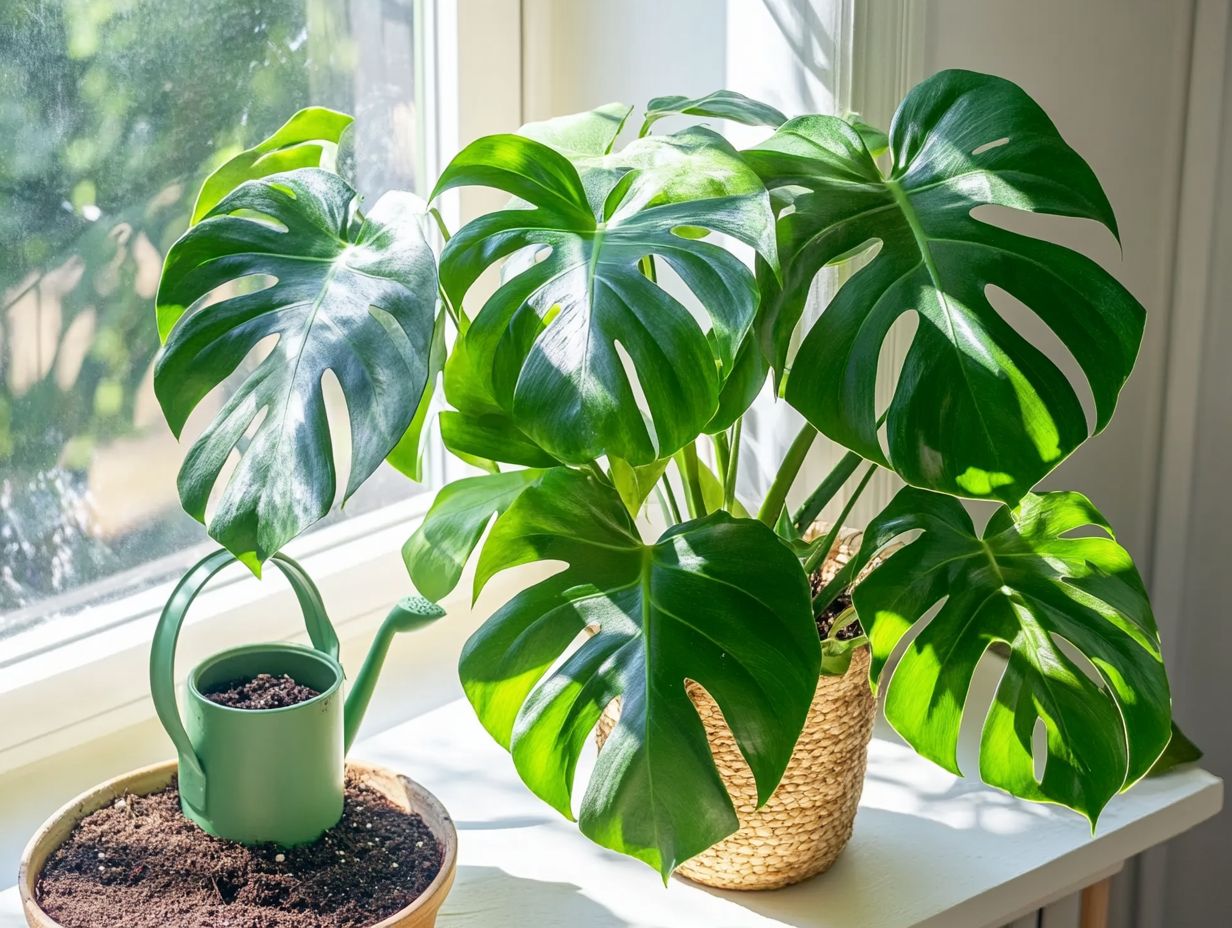
Understanding the common pests and diseases that afflict Monstera plants is essential for safeguarding their health and longevity. Pests like spider mites and mealybugs can escalate into substantial issues if not tackled swiftly.
Recognizing the early signs of disease and adopting preventive measures will help your Monstera thrive without complications. Consistent monitoring and attentive care are key to averting these frequent challenges, ensuring your Monstera remains vibrant and healthy.
Identifying and Treating Common Issues
Identifying and addressing common issues in your Monstera plants is crucial for maintaining their health and aesthetic appeal. Pests like aphids and scale insects can wreak havoc if left unattended. By conducting regular health checks and knowing what to look for, you can diagnose and treat potential problems before they escalate.
Start by closely examining the leaves for any discoloration, curling, or unusual spots these could be early warning signs of distress. Check the soil moisture; overwatering might lead to root rot, while under-watering can result in wilting.
For pest management, consider introducing natural predators, such as ladybugs for aphids, or using insecticidal soap for effective treatment. Keep an eye on humidity levels and ensure proper drainage for healthy growth.
By familiarizing yourself with these early indicators and treatment options, you can foster vibrant growth and longevity for your beloved Monstera.
Troubleshooting Tips
Troubleshooting tips for Monstera plant owners can elevate your indoor gardening experience. A prevalent concern is whether Monstera is toxic to cats, which is crucial for households with furry companions.
Swiftly identifying any issues with your Monstera ensures timely interventions, helping your plant thrive. By adhering to essential Monstera care advice and tackling common problems head-on, you can cultivate a vibrant indoor environment that flourishes beautifully.
How to Revive a Dying Monstera Plant
Reviving a struggling Monstera plant requires immediate attention to the issues affecting its health. Common problems like improper watering, insufficient light, or pesky pest infestations can quickly lead to drooping leaves and stunted growth.
By checking the health of your Monstera and pinpointing the exact issues, you can implement effective corrective measures that will breathe new life into your plant. With the right care, your Monstera can not only bounce back but thrive once again.
Start by examining the leaves for any discoloration or browning, as these symptoms may suggest overwatering or a lack of nutrients. Ensure that the pot has proper drainage to avert root rot, which is a frequent concern for these tropical beauties.
Check the soil moisture by inserting your finger to determine whether it’s time to water; ideally, you want the top inch to dry out between waterings. Pay attention to the light conditions as well; a Monstera thrives in bright, indirect light. If your plant is in a dark corner, move it to a brighter spot gradually. For those interested in expanding their collection, learn how to propagate Monstera plants to enjoy more of these beautiful greens.
After identifying the causes of its decline, take proactive steps such as adjusting the watering schedule or relocating the plant to significantly enhance its chances of recovery.
Frequently Asked Questions
- What is a Monstera plant and how do I care for it indoors? A Monstera plant, also known as a Swiss cheese plant, is a popular indoor plant with unique, large, and holey leaves. To care for it, place it in bright, indirect sunlight and water it once a week or when the top inch of soil is dry.
- Can I grow a Monstera plant indoors if I don’t have a lot of natural light? Yes, Monstera plants can tolerate low light conditions, but they may not grow as quickly or produce larger leaves. If possible, try to provide it with at least some natural light to keep it healthy and thriving.
- How often should I fertilize my Monstera plant? During the growing season (spring and summer), fertilize once a month with a balanced, water-soluble fertilizer. Stop fertilizing during winter when the plant is dormant.
- My Monstera plant’s leaves are turning yellow, what does this mean? Yellow leaves can indicate overwatering, underwatering, or lack of nutrients. Check the soil moisture and adjust your watering schedule. If leaves stay yellow, consider fertilizing or repotting.
- Do I need to prune my Monstera plant? Pruning isn’t necessary but can help control size and shape. Trim off any dead leaves or unruly growth to encourage new growth and keep the plant looking full.
- Can I propagate my Monstera plant indoors? Yes, propagate by taking stem cuttings and placing them in water or soil. Ensure cuttings have a node, which is the point where a leaf attaches to the stem, and keep the medium moist until new roots and leaves appear.

